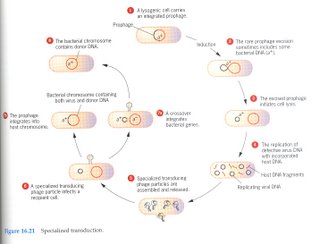
Generalised Transduction
Snustad. Simmons. Jenkins: principles of genetics (575.1 SNU)
The above book covers bacteria and virus pretty well although it may be a bit extensive. For those who wants to know more, you can seek out this book in the library =)
To answer a question that was posed this morning Wed 12/9 (notes is not wrong but probably unclear).
Transduction:
1) Generalised - the phage can transfer any segment of the bacterium genome to another bacterium.
2) Specialised – only restricted segments of the bacterial genome is transferred (those close to the integration site)
Generalised Transduction
From the above diagram and notes:
a defective phage is one that contains bacterial DNA and no phage DNA.
At the end of the lytic cycle, viral DNA is being packed into the phage and so are some of the bacterial chromosome fragments. This packing error will give rise to some phages with viral DNA and others with only bacterial DNA. Size of the bacterial fragments will vary.
Since this defective phage does not contain viral DNA, (after adsorption and injection of the bacterial fragments into a new bacteria cell) no new bacteriophage is synthesized in the recipient bacterial cell.
Specialised Transduction
There is the lysogenic state and en face with an induction event, the excision of prophage is erroneous, removing a phage genome with some of its genetic material replaced by (particular) bacterial genetic material. The recombinant viral DNA that is produced this way is usually defective because some of its own genetic material is left behind.
This new circularized recombinant genome can still undergo replication because its origin of replication is intact and the DNA polymerase is non-discriminating so you can get many of such DNA.
However, when the recombinant DNA is packaged within a capsid and the transducing particle injected it into a new bacterial cell, since part of the viral genome has been deleted, no progency virus can be formed in this bacterium because the necessary (viral) enzymes are not present*.
Recombination can take place as in diagram or there is integration of the DNA due to a common gene.
*this may be dependent on the site where the viral genome is cut, whether genes are removed. But usually they are and thus rendering the virus defective.

Specialised transduction

Examples of recombination close-up

Integration requires one-point

Recombination requires two-points

Diagram showing integration of F plasmid into bacterial chromosome.
Correct and Incorrect excision of F plasmid.





2 comments:
hm mr chan, why the defective phage in transduction can still attach to another bacteria cell even though it doesn't have any genetic material of its own?
is it like the movement and attachment of the phage does not really require genetic material?
so if like there's a packaging mistake before the cell lyse, and one of the phages doesn't get packaged with any genetic material at all, it will still be able to move and attach to another bacteria cell? (even though it's quite useless.)
you are right.
The attachment and injection is not dependent on genetic material. Even with a non-defective phage, the genetic material within has no real function until entry into host cell i.e. it is not used to transcribed etc in the phage since no machinery is present.
Thus a phage can too be an empty one during assembly which is spontaneous and random
Post a Comment